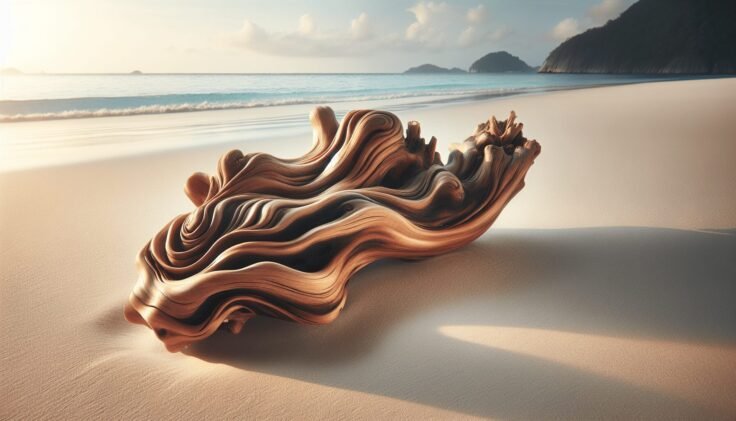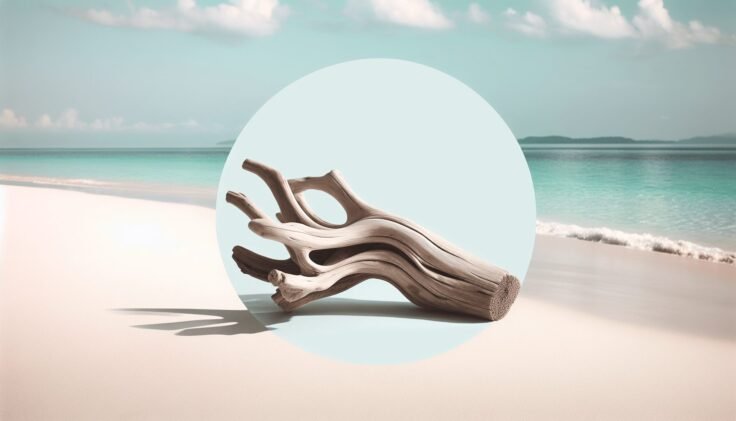Have you ever strolled along a beach, marveling at the unique beauty of driftwood washed ashore by the relentless tides? There’s something incredibly captivating about the elegance of driftwood. It’s more than just wood and history; it’s a piece of art crafted by nature herself.

What is Driftwood?
Driftwood is essentially pieces of wood that have been washed into rivers, lakes, or oceans and eventually delivered to shores by the forces of nature. These wooden pieces are distinguished from other debris by their unique qualities and aesthetic appeal.
The Formation Process
Driftwood starts its journey as a tree in a forest. Over time, it might break off due to storms, logging, or natural decay, finding its way into water bodies. Then begins an incredible transformational journey through the elements. Submerged and swept along by water currents, these pieces undergo a natural sculpting process. They’ve possibly traveled for years before reaching you, their surface smoothed by constant motion, elements, and time.
Characteristics of Driftwood
Driftwood is distinct due to its beautifully contorted shapes and smooth surfaces. The texture can vary based on the type of wood and its journey. Sometimes, you might notice growth rings, knots, or even boreholes created by marine life. Each piece tells its own story, from rustic textures to intricate grains making every piece truly one of a kind.
Types of Driftwood
Various trees can produce driftwood, each contributing to unique textures, colors, and densities. Here, we’ll explore some of the common types:
Cedar Driftwood
Cedar is known for its rich color variations and delightful aroma. It’s lightweight while being highly durable, resisting decay over time. Cedar driftwood usually has a red to deep brown appearance, making it a favorite among artisans.
Oak Driftwood
Often denser and heavier, oak driftwood features tight grain patterns. Its strength and durability come through even after a long journey at sea. The colors range from light brown to black, depending on exposure and aging.
Pine Driftwood
Light, almost white, pine driftwood is soft and easy to manipulate. It’s often found in cooler climates and may exhibit lighter hues typically fading to gray or silver as it ages.
Maple Driftwood
Known for its potentially twisted forms, maple driftwood provides an opportunity for unique sculptures. It’s often light and possesses a subtle luster, adding a delicate aesthetic to its rugged background.

Uses of Driftwood
Driftwood transcends from being just a beautiful, naturally carved piece of wood to serving purposeful uses in several areas. Let’s look at some applications of driftwood, which might inspire you to incorporate it creatively into your life.
Home Decor
Driftwood’s unique forms can add a rustic and elegant touch to your home. Due to its natural beauty, many use driftwood in creating centerpieces, mirrors, photo frames, or even light fixtures. They can enhance interiors by adding a touch of coastal charm or rustic allure to various styles.
Furniture
From coffee tables to wall-mounted shelves, driftwood can be worked into various types of furniture. Its natural weathering adds an antique aura that many find fascinating. Imagine a piece of furniture that not merely serves its practical purpose but also acts as an artistic centerpiece.
Garden and Landscaping
Driftwood is an exceptional addition to any garden. It can serve as a natural sculpture or barrier and is also often used in terrariums and aquariums. The wood can be integrated into garden pieces, creating harmonious interactions between plant life and wooden art.
Artistic Creations
Many artists find inspiration in driftwood due to its unique and intriguing forms. It can be transformed into sculptural art or crafted into beautiful carvings, showcasing the elegant artistry which nature initiates and the human hand completes.
How to Clean and Preserve Driftwood
Once you’ve found your perfect piece, you might want to clean and preserve it, ensuring longevity and continued aesthetic enjoyment.
Cleaning Driftwood
Soaking: Immerse driftwood in a large container full of water to eliminate salt and any sea odor. Change the water every few days to aid leaching.
Scrubbing: Use a soft brush to scrub away any residual dirt, algae, or barnacles. Be gentle to avoid damaging the wood.
Rinsing: Thoroughly rinse with clean water, ensuring the removal of all remnants of cleaning agents.
Preserving Driftwood
Drying: Allow your cleaned piece to dry naturally in the sun. This helps in discouraging mold growth and maintains the structure firm.
Sealing: Consider applying a coat of clear wood sealant, which will protect the wood from drying out excessively and losing its form over time.
Displaying: Keep away from excessive humidity. Ensure it’s placed where it can remain dry and well preserved.
Emotional and Historical Significance
Driftwood is not solely aesthetic; it holds a deeper connection with time and nature’s journey. Consider this while marveling at your next driftwood find.
Connection with Nature
Driftwood embodies the life cycle of the tree, illustrating the resilience and grace of nature. Each piece is a tactile reminder of a tree’s life, its end, and a new chapter washed up on our shores.
Environmental Symbolism
Driftwood serves as a poignant representation of erosion, the water cycle, and the narrative of the natural world. For many, collecting or working with driftwood is engaging with an intertwined story of land and sea, growth, and transformation.
Some Creative DIY Driftwood Projects
Getting hands-on with driftwood can be a fulfilling creative endeavor. Here are some projects you can attempt:
Driftwood Candle Holder
You can make rustic candle holders by securing candles within a piece of driftwood. It requires minimal tools and yields results centered around warm, ambient aesthetics.
Driftwood Planter
Create a unique planter by crafting out hollow spaces within the driftwood to accommodate small succulents or decorative plants.
Driftwood Wall Art
Utilize multiple smaller pieces to design intricate wall art or a picture frame. Driftwood art can depict abstract forms or incarnate objects, lending creativity and intricate beauty to your space.
Sustainable Practices in Driftwood Collection
While driftwood offers charming benefits, it’s critical to adhere to sustainability practices.
Responsible Collection
Ensure you’re gathering driftwood responsibly, being mindful of local laws. Overcollection can interfere with natural habitats or coastal ecosystems. Always leave enough for nature and others to enjoy.
Eco-friendly Crafting
Use natural or recycled craft materials, and be mindful of using environmentally-friendly finishes or adhesives.
Supporting Through Purchase
Consider purchasing artisan craft items made from driftwood. This not only supports local craftspeople but also ensures a balance in demand and ecological respect.
Conclusion
Driftwood, elegant in its intricate dance through nature, is a product of time and elements. Its uniqueness offers endless opportunities for functional beauty and artistic expression. Next time you find a piece on a beach walk, you’ll see more than just a piece of weathered wood. You’ll see history carved into its surface, a testament to both resilience and the journey of transformation led by nature. Embrace the elegance of driftwood, allowing it to inspire creativity and appreciation for nature’s artistry while respecting and preserving its natural history.